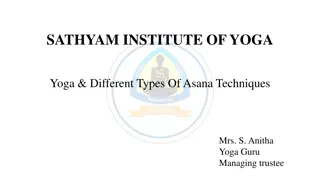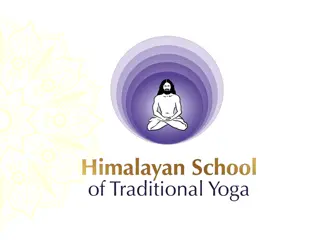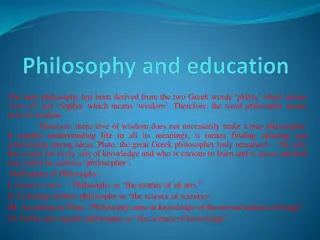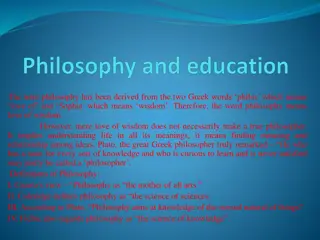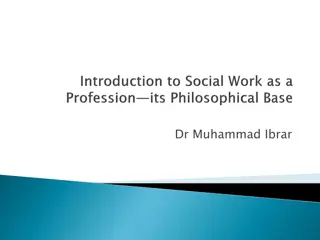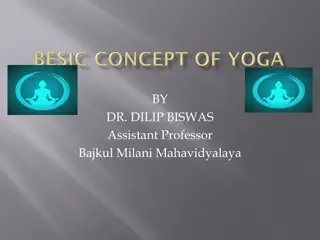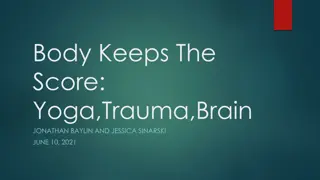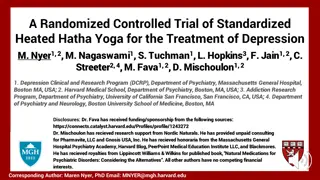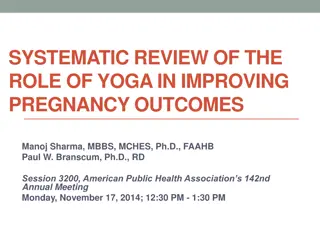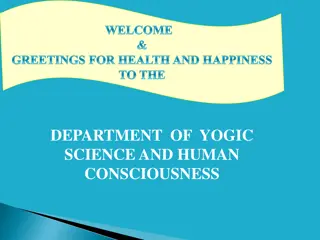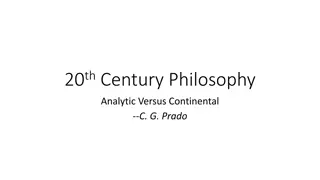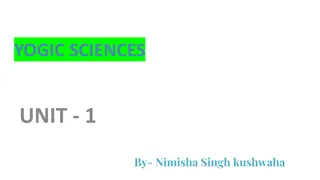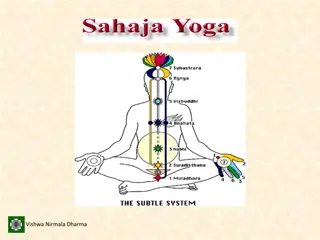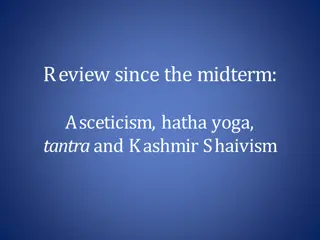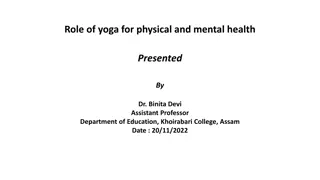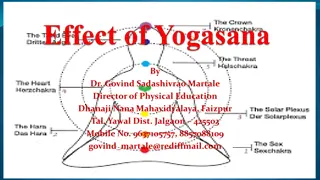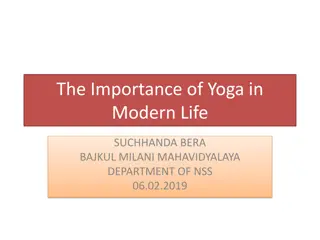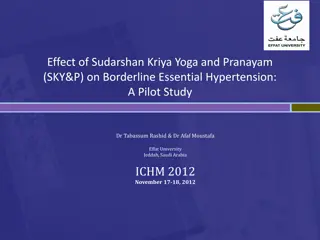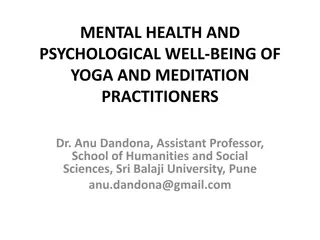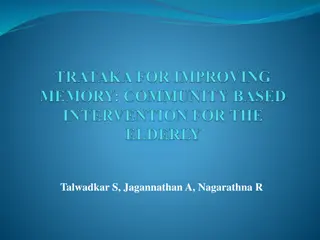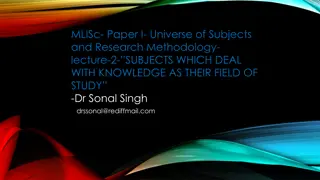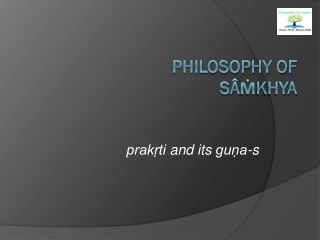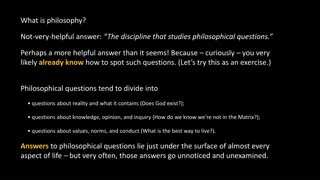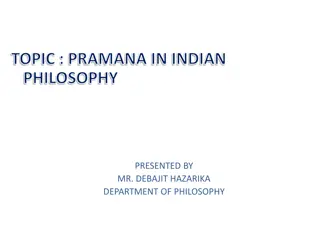Understanding Yoga Philosophy: Insights from Patanjali's Yoga Sutra
Yoga philosophy, founded by Sage Patanjali, explores the union of mind and body through practices like Viveka and Cittavritti. The Yoga Sutra delves into stopping mental modifications and identifies five types of Cittavrittis. These include Pramana (valid knowledge), Viparyaya (false cognition), Vikalpa (verbal cognition), Nidra (sleep), and Smriti (memory). Each type plays a crucial role in understanding consciousness and the mind-body connection.
Uploaded on Sep 28, 2024 | 0 Views
Download Presentation

Please find below an Image/Link to download the presentation.
The content on the website is provided AS IS for your information and personal use only. It may not be sold, licensed, or shared on other websites without obtaining consent from the author. Download presentation by click this link. If you encounter any issues during the download, it is possible that the publisher has removed the file from their server.
E N D
Presentation Transcript
GE 3: Yoga Philosophy Patanjali is The Founder of Yoga Philosophy or Yoga Darshan. Yoga-sutra or Patanjali-sutra or Patanjala-sutra is written by Sage Patanjali. It is the first work of Yoga Philosophy.
Yoga means Union. It is the Union of Mind and Body . Practice of Yoga as the sure means of attaining Vivekaj n or discriminative knowledge. Yoga is the application of the theory of Sankhya in practical life. Cittavritti means modification of Mind .
Cittavrittinirodha or to stop the Modifications of Mind . That means, Cessation of mental modifications or functions. Five types of Cittavrittis or mental modifications.
Five types of Cittavrittis or mental modifications. 1. Pramana (right or true or valid cognition or knowledge). 2. Viparyaya (False or wrong cognition or Knowledge). 3. Vikalpa (Merely verbal cognition). 4. Nidra (sleep). 5. Smriti (memory).
Pramana: Sources of valid or Right or True cognition. a) Pratyaksa or Perception. b) Anumana or Inference. c) Sabda or Verbal Testimony.
Viparyaya: Invalid or false or wrong cognition. It is the false or wrong knowledge of object as they really are not and it includes doubt or uncertain cognitions.
Vikalpa It is the merely verbal cognition. It is the mere idea caused by words, to which no real facts correspond. (Example: Soul and consciousness both are identical)
Nidra It is due to the preponderance of tamas in citta and the consequent cessation of waking consciousness experiences. and dream It stands for dreamless sleep (susupti). There mental function or state of consciousness even at deep sleep.
Smriti Smriti or memory is the reproduction of past experiences without any alteration or innovation.
Astanga Yoga or Eight-fold Means of Yoga 1. Yama or Restraint. 2. Niyama or Culture. 3. sana or Posture. 4. Pr y ma or Controlling breath. 5. Praty h ra or Withdrawal of the senses. 6. Dh ran or Attention. 7. Dhy na or Meditation. 8. Sam dhi.
Yama a) Ahi s : Non injury. Abstention from any kinds of injury to any life. b) Satya: Truthfulness in thought and speech. c) Asteya: Non stealing. d) Brahmacarya: Control of the carnal (related to physical) desires and passions. e) Aparigraha: Non acceptance of unnecessary gifts from other people.
Niyama Cultivation of the good habits. a) auca or Purification. (Mind and body) b) Santo a or the habit of being content with what comes from itself without undue exertion. (Unwanted or inappropriate or excessive which is done by lots of effort. c) Tapas or Penance which consists in the habit of enduring cold and heat etc. and observing austere vows. d) Sv dhy ya or the regular habit of study of religious books. e) I hvarapra idh na or meditation of and resignation to God.
sana sana is a discipline of the body and consists in the adoption of steady and comfortable postures. There are various kinds of sana such as padm sana, vir sana, bhadr sana etc.
These can be properly learnt under the guidance of experts. The discipline of the body is as much as necessary for the attainment of concentration as that of mind. If the body is not free from diseases and other disturbing influences, it is very difficult to attain concentration.
Hence the Yoga lays down elaborate rules for maintain the health of the body and making it a fit vehicle for concentrated thought.
Pryma It is the regulation of breath. It consists in suspension of the breathing processes either after exhalation (recaka) or inhalation (p raka), or simply by retention of the vital breath (kumbhaka).
The Details of the process should be learnt from experts. That respiratory exercises are useful for strengthening the heart and improving its function is recognized by medical person when they recommended walking, climbing etc., in a graduated scale, for patients with weak hearts.
The Yoga prescribes breath control for concentration of the mind. Because it conduces to steadiness of the body and the mind. So long as the function of breathing continues, the mind also goes on fluctuating and noticing the current air in and out.
If, and when, it is suspended, the mind is in a state of undisturbed concentration. Hence, practicing of the control of breath, the yogin can suspend of breathing for long time and thereby prolong the state of concentration.
Pratyhra It is consists of withdrawing the senses from their respective external objects and keeing them under the control of mind. When the senses are effectively controlled by mind , they follow, not their natural objects, but the mind itself.
So in this state, the mind is not disturbed by sight, sound etc. coming through the eye, ear and other senses. Keeps all of them under perfect control. This state is very difficult although not impossible to attain. It requires a resolute will and long practice to gain mastery over one s senses.
Dhra It is attention. It is Mental discipline. It consists in holding (dharana) or fixing the mind on the desired object. The ability to keep one s attention steadily (firmly fixed) on some object is the test of fitness for entering the next higher stage of Yoga.
Dhyna Dhyana is Meditation. It means the flow of thought about, or rather, round about the object of attention. It is the steadfast contemplation of the object without any break or disturbances. This has the effect of giving us a clear and distinct representation of the object first by parts and aspects.
But by long continued meditation, the mind can develop representation of the object into a full and live presentation of it. the partial Thus Dhyana reveals the reality of the contemplated object to yogin s mind
Samdhi Samadhi is the final step in the practice of Yoga. In it the Mind is so deeply absorbed in the object of contemplation that it looses itself in the object and has no awarness of itself. In the state of dhyana, the act and the object of thought remain distinct and separate state of consciousness.
But in the state of samadhi the act of meditation is not separately cognized. It takes on the form of the object and looses itself. So, here only the object of thought remains shining in the mind. We don t even know that there is a process of thought in the mind.


